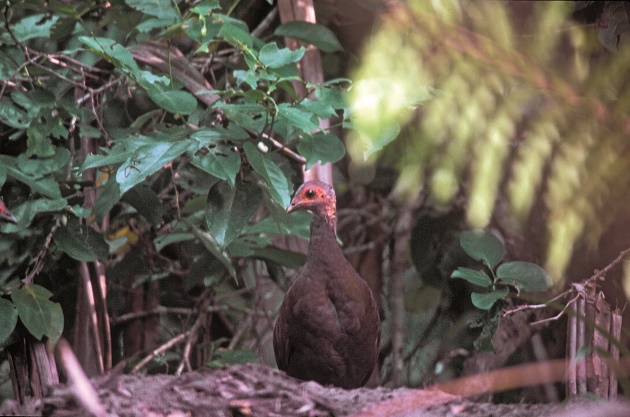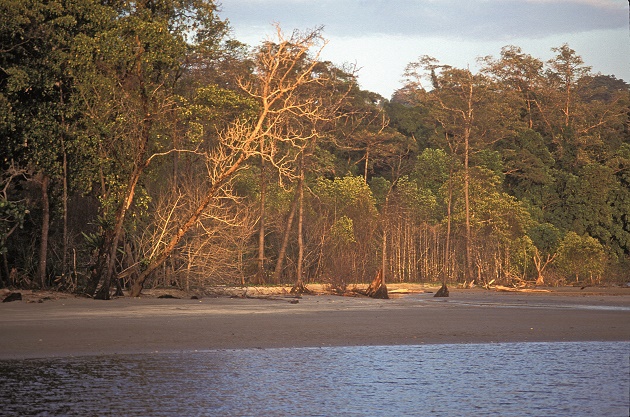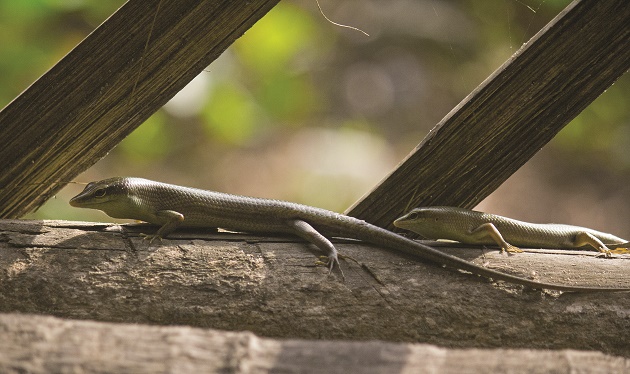Searching for Happiness
First published in Sanctuary Asia,
Vol. 38
No. 12,
December 2018
By Radhika Bhagat
An Island Lost in Time
If you sail for 537 km., southeast of Port Blair, the capital of Andaman and Nicobar Islands, you reach the southernmost tip of India, the mysterious Great Nicobar Island (6°46’N – 7°20’N and 93°37’E – 93°56’E). The land of the Nicobarese and Shompen tribes, the land of the Nicobarese crab-eating macaque, the Nicobarese tree shrew, the Great Nicobar Serpent-eagle, the saltwater crocodile, the Edible Nest Swiftlet, the dugong and uncounted more. The island is largely unexplored even by field biologists, and presents nature’s canvas at its best, with dense rainforests, lush coral reefs and with tribes living in relative isolation from the world.
Lying within the most seismically active regions of the world, the ring of fire, the island finds its earliest recorded mention in the Sri Lankan Pali Buddhist chronicles, (3rd–4th century), as Naggadipa (nagga meaning naked in Pali language). The name Kala Pani (Black Waters) is etched in almost every Indian’s psyche because the A&N Islands were used as a colonial prison and penal settlement by the British during India’s freedom struggle. As a whole, this fragile archipelago has been ravaged down the years and the many atrocities against the tribes over few centuries is well documented, particularly during its occupation by the Danish (17th century), the British (1868) and the Japanese (1942-45). Finally, in 1950, the Islands became a part of free India, but did not quite stop the ecological downslide.
Because the Great Nicobar Island lies far from the Indian mainland, thus far it has largely escaped the attention of developers and is, consequently, a treasure-trove of biodiversity. The Great Nicobar Biosphere Reserve therefore remains a wonderland of tropical wet evergreen forests, mountain ranges and coastal plains. Predictably, isolation has resulted in high endemism with such unique species as the Nicobar Megapode found nowhere else in the world.

The rare Nicobar Megapode Megapodius nicobariensis. Photo Courtesy: Pankaj Sekhsaria
The Campbell Bay National Park on the northern part of the island, and Galathea National Park in the southern interior form part of a Tribal Reserve and a Zoological Survey of India survey of the 885 sq. km. island reveals 1,767 species of fauna – 558 terrestrial and 1,209 marine, which is why in 2013, UNESCO justifiably declared this Eden a Biosphere Reserve under its Man Biosphere (MAB) programme.
With advances in science, technology and transportation there are few places in the tropical world where a sense of mystery still prevails, but surely the Great Nicobar is one such. Anthropologists have studied two forest-dwelling tribes -- the hunter-gatherer Mongoloid Shompens (about 200 in number) who live in the forests along the rivers and streams and the Nicobarese (around 300, also Mongoloid) who used to live in settlements along the west coast until the devastating tsunami of 2004, post which they were resettled to the north coast. Additionally, the Great Nicobar now has settlers and mainlanders numbering over 8,000, who occupy the southeast coast where they practice agriculture, horticulture and fishing.

The coastal forest of Galathea National Park (above) in the south of the island, along with the Campbell Bay National Park in the north sit within the region that has been declared as a Tribal Reserve. Photo Courtesy: Pankaj Sekhsaria
Wheels of Change
After living in relative equilibrium, the Nicobarese were seriously jolted by the 2004 tsunami. Besides the huge loss of life and property, a multitude of factors emerged, some on account of official post-tsunami relief efforts. Dr. Ajay Saini reveals how the government’s culturally-insensitive disaster relief led to cross-cultural exposure and disengagement from traditional practices that has forever changed their way of living. Large monetary compensation and exposure to modern amenities have sucked the Nicobarese into the whirlwind of consumerism and many are now not willing to go back to the lifestyles of their ancestors. Undoubtedly well-meaning, these humanitarian interventions have not merely undermined self-sufficient livelihood practices, social structures and the political self-organisation of the community, but have probably left the Nicobarese people almost permanently dependent on outside support.
What is more, settlers from the mainland are now mounting pressure for more development, and inappropriate livelihoods on the island. For decades there was no tourism allowed below the 10-degree channel, but today fresh tourism projects are being routinely proposed and these just might prove to be the last load on the camel’s back and could destabilise the ecology of the island, driving many species to extinction.

The isolation of the Great Nicobar Island has resulted in a large number of endemic species. The 885 sq. km. island is home to nearly 1,767 faunal species, including the Nicobar tree skink Dasia nicobarensis. Photo Courtesy: Snehaa Sundaram
And more than just ‘wild species’ could be lost forever.
Eight years ago, in February 2010, as I was surfing the Internet at my New Delhi home, I read about Boa Sr of the Bo tribe from the North Andaman Island and how she was the last remaining speaker of the Bo language. I looked at her face looking right back at me through the screen and I felt her loneliness. She belonged to one of the oldest tribes on Earth, with her died a thousand secrets of her people and their lives on the islands. This is a reminder that the threat of extinction looms large for the tribal people of Great Nicobar too.
With the loss of biodiversity, habitats, and native languages, we also lose indigenous knowledge, including the traditional ecological comprehension of the role of species and landscapes that native communities had kept alive for eons.
’Modernisation’ poses still more dangers. The archipelago is separated by over 650 nautical miles from the Indian mainland and offers a vital geostrategic advantage to India and this places it at risk from further economic and defence development. With China as a looming threat in the Indian Ocean, India plans to augment its military capability here to safeguard its interests in the Bay of Bengal and Indian Ocean. Translated, this means more infrastructure, more inappropriate (from a biodiversity point of view) technological intrusions, such as upgradation of the naval air station at Campbell Bay.
Easy accessibility is inevitably followed by economic invasion. The vast Exclusive Economic Zone, around this zone accounts for almost 30 per cent of India’s entire EEZ. What further complicates this threat to the biological existence of plant and animal lifeforms is the fact that the A&N Islands sit astride some of the busiest shipping lanes of the Indian Ocean. Facilities are being mooted to build new capacity for cargo to be transported to East Asian economies to cater to Indian interests by using the strategically-located mouth of the Malacca Straits. This gateway to the Far East is an 850 km. channel and carries 40 per cent of the world’s freight trade, which annually sees over 94,000 merchant ships sailing to and from China, South Korea and Japan alone.
The subsequent land use change and impact on biodiversity and culture in the A&N Islands has been evident in the last few years, specially post tsunami. There are plans underway for up-scaled, integrated tourism and enhanced infrastructure. Marine debris already lines the pristine beaches of Great Nicobar, threatening the breeding grounds of leatherback turtles, their hatchlings and other marine life.

Photo: Pankaj Sekhsaria
In all likelihood, humungous quantities of marine plastic debris originate from fishing or mariculture activity… and from irresponsible ship traffic. The wheels of change for Great Nicobar and other parts of the A&N Islands are in motion, and it will take a visionary, great balancing act to protect this wonderland.
Gross Island Happiness Index
Increasingly, there has been recognition that measurements such as GDP (Gross Domestic Product) do not capture the overall wellbeing of a nation’s citizens. It’s hard to not be impressed by the motivations behind Bhutan’s concept of GHP (Gross National Happiness) for its people. This involves measuring prosperity based on a broad range of factors including spiritual, physical, social and environmental health of its citizens and natural environment. Environmental conservation and sustainability are at the heart of Bhutan’s political agenda, which stems from an intrinsic belief that happiness is dependent on well-being that in turn results from close contact and balance with nature.
Islands, including the Andaman and Nicobar Islands, are specially well placed to adopt such a system of measuring prosperity. Island nations world over have a higher than average level of life expectancy, life-satisfaction and a lower-than-average ecological footprint when calculated on the lines of the Happy Planet Index (HPI). Perhaps geographical isolation from the mainland protects locals from mainland disturbances and helps them retain their unique cultural, ecological and social values.
Maintaining ecological, social and cultural balance for the A&N Islands is very much in line with UNESCO’s vision for the Great Nicobar Biosphere Reserve. A Gross Island Happiness Index for these islands would be a shining example for the rest of our country, indeed the world to emulate.

Photo: Pankaj Sekhsaria
For now, the Great Nicobar Island waits patiently for its story to unfold. Even as the tussle between human greed and nature continues, the islands happen to be among the most biodiverse places on the planet, teeming with life forms. All these, however, remain at the mercy of one species searching for gratification in all the wrong places.
Exactly a decade ago, when I first visited the Andaman and Nicobar Islands, I found myself taken by the stunning, raw, healing beauty of the islands. This marked the beginning of my wildlife conservation journey. Here, I would spend endless hours diving and walking with local guides while exploring coral reefs and rainforests. My love affair with these islands began underwater, where I lost myself in the Bay of Bengal, but found happiness.
What is MAB?
The Man Biosphere (MAB) programme combines natural and social sciences, economics and education to improve human livelihoods and the equitable sharing of benefits, and to safeguard natural and managed ecosystems, thus promoting innovative approaches to economic development that are socially and culturally appropriate, and environmentally sustainable.
The MAB Programme aims to:
- Identify and assess changes resulting from human and natural activities and the effects of these changes on humans and the environment, in particular in the context of climate change.
- Study and compare the dynamic inter-relationships between natural/near-natural ecosystems and socio-economic processes.
- Ensure basic human welfare and a liveable environment in the context of rapid urbanisation and energy consumption.
- Promote the exchange and transfer of knowledge on environmental problems and solutions, and to foster environmental education for sustainable development.
For more information, visit: Man and the Biosphere Programme
With inputs from Ram Boojh, Former Programme Chief, Ecological Sciences, UNESCO South Asia Office, New Delhi






